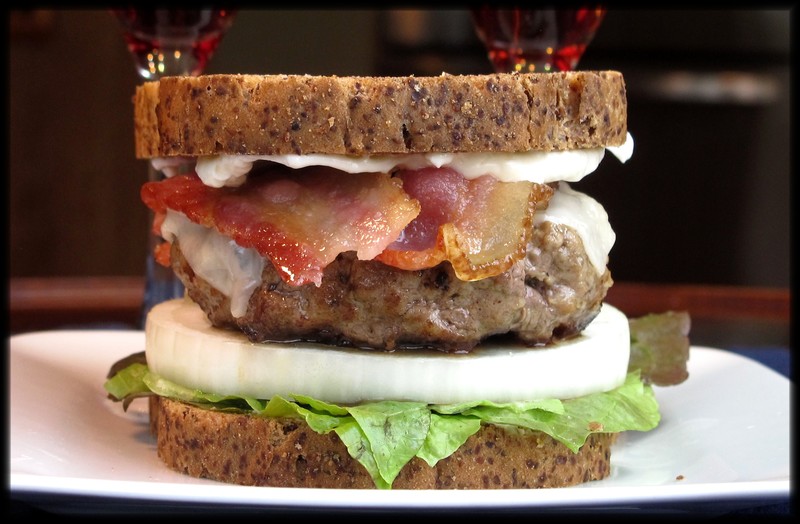Why is bacon so popular? Is it a recent phenomenon or just a resurgence of a longstanding affection for salty and crispy? A quick survey finds that Dewey Beach held a Bacon Fest in April, chocolate dipped bacon and bacon ice cream are popular treats and you can find bacon bowls hawked on television shopping networks.
However, bacon has been around for centuries. The name derives from the French and German words for “back” which is where most bacon cuts are taken. Ancient Romans treated their bacon with salt and wine before browning it. Over the years, certain breeds of pig were chosen for the quality of their bacon and the curing process was believed to have been perfected by John Harris of Wiltshire, England.
How do you make bacon? It depends on whether you’re a large manufacturer or an artisanal craftsman. Commodity producers will inject pork bellies with brine (salt and sugar) and flavorings such as liquid smoke. The slabs are usually sprayed with more liquid smoke and then baked, sliced, packaged and shipped to your local grocery distributer.
The ratio of meat to fat is ideally one to three, but we’ve all opened those plastic packages and found almost nothing that could be considered cured meat. Because of all that fat, bacon shrinks considerably when it’s cooked, leaving behind rendered fat (great for seasoning other fried dishes) and a shriveled sliver of crunch.
Artisanal bacon producers will either dry cure (comparable to using a rub) or wet cure the slab. Dry curing can be less effective, as the salty liquid has a better chance of thoroughly penetrating the meat and fat. Once the brine has had its week under refrigeration to flavor the slab, you’re ready for the smoking step. Here’s where the type of wood can affect the results; hickory and maple are quite popular for the unique flavor they impart.
Smoking requires the ability to place the slab under indirect heat. A gas grill can only work if there’s a shelf well away from the flame of the gas ring. A smoker is the best way to go, because you can control the temperature and volume of the smoke. Remember, you’re smoking, not cooking the meat, so this step should take only a couple of hours.
If you decide to purchase bacon from a supermarket, you’ll find better quality in the thicker-sliced varieties; sometimes the thin slices become tangled fat snarls. Also, you can jazz up the flavor and texture with cracked peppercorns scattered over the slices. Baking bacon on a rack over a rimmed pan will give you the leanest result, while cooking it in a skillet gives you wonderful brown bits and rich fat in which to sauté your hash browns.
What else can you do with bacon besides accompany your morning eggs? Why not try making a real bacon burger? Simply grind raw bacon in a food processor until it’s pale-colored, shredded fat. Mix this with ground beef and form into patties. After they’re grilled, you may decide you don’t need to add any bacon slices to your burger as we did for the photo.
Another popular trend is the bacon bowl. You can find these online or in your grocer’s freezer section. They’re simply cooked bacon slices formed into the shape of a cup about the size of your palm. Their suggested uses include fillings ranging from scrambled eggs to tuna salad to chocolate ice cream.
You don’t need to buy a specially-designed plastic mold sold for an outrageous sum during infommercials, just use a muffin tin. Either line each cup with overlapping bacon strips or drape bacon over the upside down cups and bake until the bacon is crisp.
Now that you have a few new ways to use it, you can start working on your share of the 18 pounds of bacon the average American eats each year.
Bacon Burgers
1/4 lb bacon
1 lb ground beef
garlic powder
salt & pepper, to taste
Cut the bacon into one-inch pieces and place in the bowl of a food processor. Pulse until the bacon has been thoroughly pureed. In a large bowl, mix the ground bacon with the ground beef until completely incorporated. Form into 4 or 5 patties and season with garlic powder, salt and pepper. Grill or sauté to desired degree of doneness.
Bacon Bowls
12 slices bacon
Preheat oven to 375 F. Cut 6 bacon slices in half, leave the remaining slices intact. Invert a 6-cup muffin tin. Drape two half-slices over the cup, overlapping to cover completely. Take a full slice and wrap it around the outside, overlapping the ends. Place the prepared tin in a rimmed baking pan and bake until cooked but not too crisp, about 15 to 20 minutes. Yield: 6 cups.
Bacon Jam
2 lb bacon
3 large onions
5 cloves garlic
2/3 C apple cider vinegar
2/3 C brown sugar, packed
1 C brewed strong coffee
1/3 C maple syrup
1 t black pepper
Cut bacon into one-inch pieces. Sauté bacon in a deep, heavy skillet over medium-high heat until browned and crisp. Remove bacon to paper towels to drain. Pour off bacon drippings (save for another use) reserving 2 T in the pan. Thinly slice onions; peel and crush the garlic. Return pan to medium heat; add onion and garlic. Cook, stirring regularly until softened and fragrant, about 5 minutes. Stir in vinegar, sugar, coffee and syrup. Bring to a boil and simmer briskly for 3 minutes.
Add bacon and reduce heat to low. Continue cooking, stirring often until onions begin to disintegrate and mixture is quite thick. Remove from heat and cool for 10 minutes. Transfer jam to the bowl of a food processor and pulse a few times to reach a spreadable consistency. Store under refrigeration in a glass jar with tight-fitting lid.














































